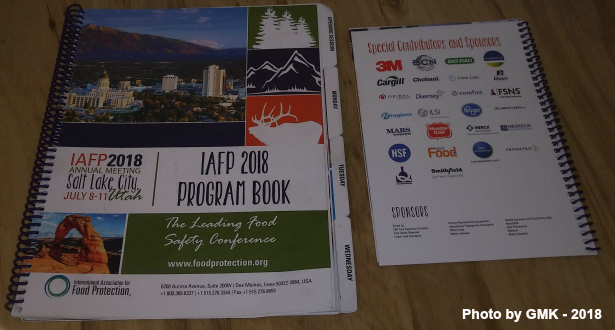The Cost of Corporate Protection in Minnesota
July 10, 2018The Planned Destruction of the American Dairy Farmer
August 3, 2018By Pete Kennedy, Esq.
The International Association of Food Protection (IAFP) held its annual meeting July 8-11 at the Salt Palace Convention Center in Salt Lake City, Utah. The event is the world’s largest food safety conference. The IAFP meeting is where food safety professionals meet to discuss pathogens in food and ways to prevent and respond to the problems those pathogens cause. The meeting is an incubator for the one-size-fits-all food safety laws that make it more difficult for small farmers and artisan food producers to make a living. Most of the crowd at the meeting does not distinguish between the industrial food system and the local food system; the regulations the conference sets in motion are geared for industrial food production and distribution and should apply to all food production and distribution in the eyes of the majority of attendees.
Food safety is a growth industry. Globalization and deteriorating quality in the industrial food system are drivers. Over 3,500 attended this year’s meeting; FDA and USDA both sent dozens of personnel to Salt Lake City. State regulatory agencies, academia (students and faculty) and big business were all well represented at this year’s meeting. Cargill, Merck Animal Health, Smithfield, Kroger, the Grocery Manufacturers Association and Walmart were all sponsors of the event.
Food safety is about the prevention of or response to cases of acute illness; there was little mention at the meeting about nutritious or nutrient-dense food and its role in the prevention of chronic disease.
A point those at the meeting frequently discussed was the complexity of long supply chains starting with the manufacturers of ingredients used by the food producer and continuing through various phases of distribution leading to the purchase of the food by the final consumer. The talk was about difficulties in traceability and ensuring safe food along the supply chain. An antidote to this problem would be to facilitate the local production and distribution of food with its short, direct supply chain, and high level of traceability but that was a solution that was seldom, if at all, brought up at the meeting.
Presentations at the meeting included talks on recent outbreaks, developments in testing for pathogens, and various food safety processes such as HACCP. At the same time the presentations are taking place, there is a trade show where vendors showcase, among other things, the latest products for testing and sanitation measures. Also present in the same location as the trade show are posters (written summaries) of studies related to food safety that are displayed for viewing by meeting attendees. Individuals who worked on the studies are present to answer questions.
Some takeaways from the meeting:
- The FDA’s longtime plan to extend the aging requirement for raw cheese from 60 days to 90 days is alive and well. Part of the evidence for the latest push on this 90-day requirement is an FDA study on how raw gouda cheese inoculated with listeria still contained listeria after 90 days. The FDA scientists who spoke on the study at the meeting acknowledged that the raw milk used in the experiment was intended for pasteurization not direct consumption–a continuation of the agency’s refusal to recognize that raw milk for the pasteurizer and raw milk for the consumer are two different products. Two food safety professionals contacted at the meetings said privately that listeria was a bigger health threat in pasteurized cheese than it was in raw cheese. Regardless, those at the meeting overwhelmingly favor the “kill step” of pasteurization for all dairy products and for other foods.
- A high-ranking USDA official disclosed that the Office of Investigation, Enforcement and Audit (OIEA), a division of USDA’s Food Safety Inspection Service (FSIS), has undertaken an initiative to increase inspections of small and very small plants (e.g., slaughterhouses and processing facilities); there is evidence that this initiative includes inspecting small food buyers clubs selling meat to their members. The question is why? As of 2016 there were only 150 OIEA inspectors in the whole country. Few, if any, food safety problems have been attributed to small plants and very small plants much less to small private food buyers clubs. Wouldn’t it be a more productive use of resources to have the OIEA personnel increase oversight for imported meat and large USDA facilities slaughtering 300-400 cattle an hour–where there are many more food safety problems?
- A high-ranking FDA official spoke about the proposed merger of food regulation between USDA and FDA with the former taking over all food regulation The official said it could be a long process but did not dismiss the merger. The merger would likely be an improvement over the current situation; FDA policies on positive bacteria test results are more strict than either the USDA or European Union countries and lead to more cases of quality, safe food winding up in a landfill.
- One of the featured speakers at the meeting supported the universal adoption of the FDA Food Code, a burdensome regulatory scheme whose cost of compliance is difficult to afford for many small farmers and local artisans producing nutrient-dense food. The late Sue Wallis, the legislator who initially introduced the Wyoming Food Freedom Act, indicated that the main reason she introduced the legislation was to get local food producers selling direct-to-consumers as far away from the requirements of the Food Code as possible. Since 2015 four states–Wyoming, North Dakota, Utah and Maine–have passed food freedom legislation allowing for the unregulated sale of food direct to consumers. As far as is known not a single foodborne illness outbreak has been attributed to a producer operating under these laws in any of the four states.
- Bill Marler, regarded by many as the leading foodborne illness personal injury lawyer in the country, acknowledged that in his 25 years of experience he could not recall having a single client sickened by food purchased at a farmers market.
- There was lots of discussion at the meeting about the recent outbreak attributed to the consumption of romaine lettuce where 5 people died and over 200 others became ill. It turns out that the plant which processed the lettuce was subject to the requirements of the Food Safety Modernization Act (FSMA). Excessive regulation from FSMA doesn’t necessarily mean greater food safety but can mean a decline in food safety with small and midsize producers going out of business due to being unable to afford the cost of compliance.
- Out of 50 states, 46 have signed cooperative agreements with FDA, receiving federal grant money in return for carrying out inspections to enforce FSMA’s federal produce safety. An attendee at the conference from a state public health department related how her department ran out of the federal money in carrying out a cooperative agreement with FDA and had to tap into a state general fund to get more money to finish carrying out the agreement. This is not uncommon. State agencies signing cooperative agreements with FDA should have a clause in the agreement that they do not have to carry out any further duties under it if the federal money runs out.
- Most of the presentations and posters at the meeting had to do with industrial food but there were at least a couple exceptions that were favorable to local food. A USDA scientist did a presentation on pastured poultry reporting among other things that poultry fed a soy-free diet had substantially less campylobacter in their systems. There was a poster on the quality of raw milk for retail sale in Maine reporting on the low incidence of illness attributed to raw milk consumption in that state.
- The atmosphere at the meeting was friendly, a good one for engaging attendees on why locally-produced food should not be regulated the same as industrial food. Most of those attending are trained that there is only one food system. One individual who worked on a poster supporting more regulation of cottage food producers was asked if she was aware of any cases of foodborne illness attributed to the consumption of cottage foods. She said no but then added that it was because cottage foods weren’t traceable. In general there are hardly any foods that are more traceable than cottage foods.
Most cases of foodborne illness are caused by industrial food; this is true even when factoring in the market share industrial food has compared to local food. Unregulated local food producers have plenty of incentive to produce safe food: their families consume the same food they are selling, one recall can put them out of business, and one case of foodborne illness can put them out of business. Food safety regulators like dealing with short supply chains and a high degree of traceability; local food producers–regulated or not–satisfy both of these parameters
When you also factor in the amount of chronic illness the local food and industrial food systems are responsible for, there is no question the local food system is responsible for fewer cases of chronic illness even when the market share of the two systems is accounted for. Take a survey on the demand those who obtain a majority of their food from the local system make for services on the medical system versus those who obtain a majority of their food from the industrial system. Policymakers should take both acute and chronic illness into consideration when crafting food regulations and legislation. The more local food producers there are the less demand there will be on the medical system for services; food freedom laws lead to more local producers.
The IAFP meeting is a place where ideas for food safety legislation are first introduced. It can also be the place where the effort begins to convince regulators that there are two food systems and that one-size-fits-all food safety regulation doesn’t work.
Food safety professionals have done a great job improving safety in areas of the industrial food system; often when dealing with multiple producers/distributors and multiple countries in an investigation–thankless work. Laws and policies contributing to an increase in local food production would make their jobs easier.



